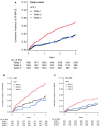Impact of Chronic Kidney Disease on the Associations of Cardiovascular Biomarkers With Adverse Outcomes in Patients With Suspected or Known Coronary Artery Disease: The EXCEED-J Study
- PMID: 35048713
- PMCID: PMC9238479
- DOI: 10.1161/JAHA.121.023464
Impact of Chronic Kidney Disease on the Associations of Cardiovascular Biomarkers With Adverse Outcomes in Patients With Suspected or Known Coronary Artery Disease: The EXCEED-J Study
Abstract
Background The impact of chronic kidney disease (CKD) on the prognostic utility of cardiovascular biomarkers in high-risk patients remains unclear. Methods and Results We performed a multicenter, prospective cohort study of 3255 patients with suspected or known coronary artery disease (CAD) to investigate whether CKD modifies the prognostic utility of cardiovascular biomarkers. Serum levels of cardiovascular and renal biomarkers, including soluble fms-like tyrosine kinase-1 (sFlt-1), N-terminal pro-brain natriuretic peptide (NT-proBNP), high-sensitivity cardiac troponin-I (hs-cTnI), cystatin C, and placental growth factor, were measured in 1301 CKD and 1954 patients without CKD. The urine albumin to creatinine ratio (UACR) was measured in patients with CKD. The primary outcome was 3-point MACE (3P-MACE) defined as a composite of cardiovascular death, nonfatal myocardial infarction, and nonfatal stroke. The secondary outcomes were all-cause death, cardiovascular death, and 5P-MACE defined as a composite of 3P-MACE, heart failure hospitalization, and coronary/peripheral artery revascularization. After adjustment for clinical confounders, sFlt-1, NT-proBNP, and hs-cTnI, but not other biomarkers, were significantly associated with 3P-MACE, all-cause death, and cardiovascular death in the entire cohort and in patients without CKD. These associations were still significant in CKD only for NT-proBNP and hs-cTnI. NT-proBNP and hs-cTnI were also significantly associated with 5P-MACE in CKD. The UACR was not significantly associated with any outcomes in CKD. NT-proBNP and hs-cTnI added incremental prognostic information for all outcomes to the model with potential clinical confounders in CKD. Conclusions NT-proBNP and hs-cTnI were the most powerful prognostic biomarkers in patients with suspected or known CAD and concomitant CKD.
Keywords: biomarker; cardiovascular events; chronic kidney disease; coronary artery disease; mortality; prospective cohort study.
Figures


References
-
- Levey AS, Eckardt KU, Tsukamoto Y, Levin A, Coresh J, Rossert J, De Zeeuw D, Hostetter TH, Lameire N, Eknoyan G. Definition and classification of chronic kidney disease: a position statement from Kidney Disease: Improving Global Outcomes (KDIGO). Kidney Int. 2005;67:2089–2100. doi: 10.1111/j.1523-1755.2005.00365.x - DOI - PubMed
-
- Levey AS, Atkins R, Coresh J, Cohen EP, Collins AJ, Eckardt K‐U, Nahas ME, Jaber BL, Jadoul M, Levin A, et al. Chronic kidney disease as a global public health problem: approaches and initiatives—a position statement from Kidney Disease Improving Global Outcomes. Kidney Int. 2007;72:247–259. doi: 10.1038/sj.ki.5002343 - DOI - PubMed
Publication types
MeSH terms
Substances
LinkOut - more resources
Full Text Sources
Medical
Research Materials
Miscellaneous

